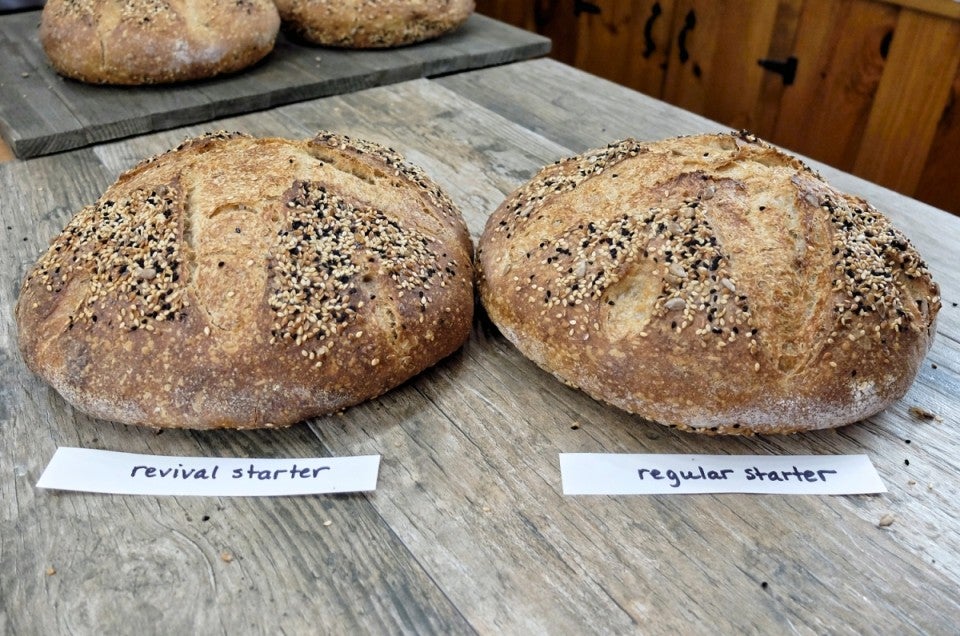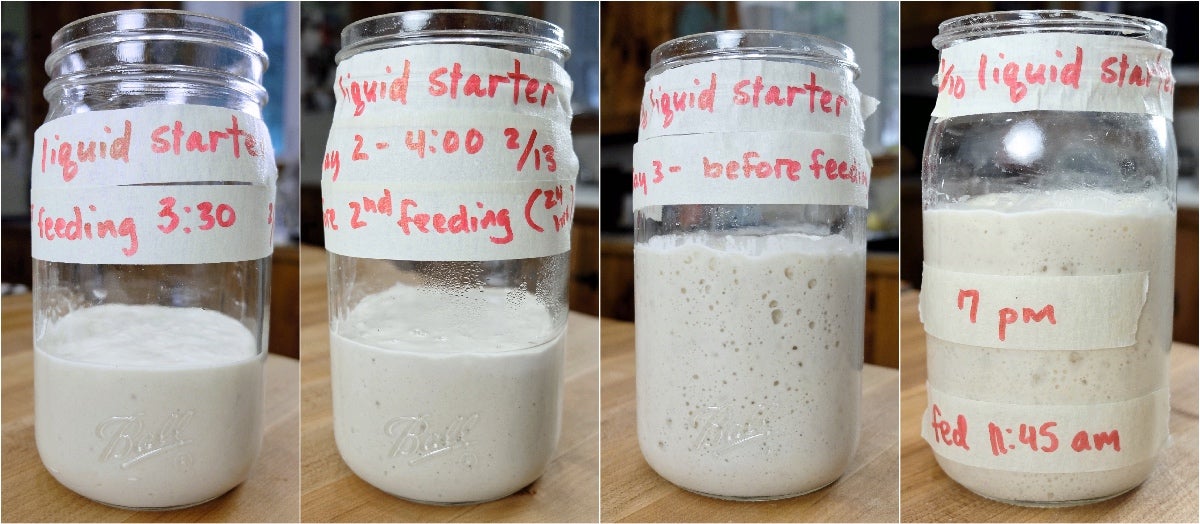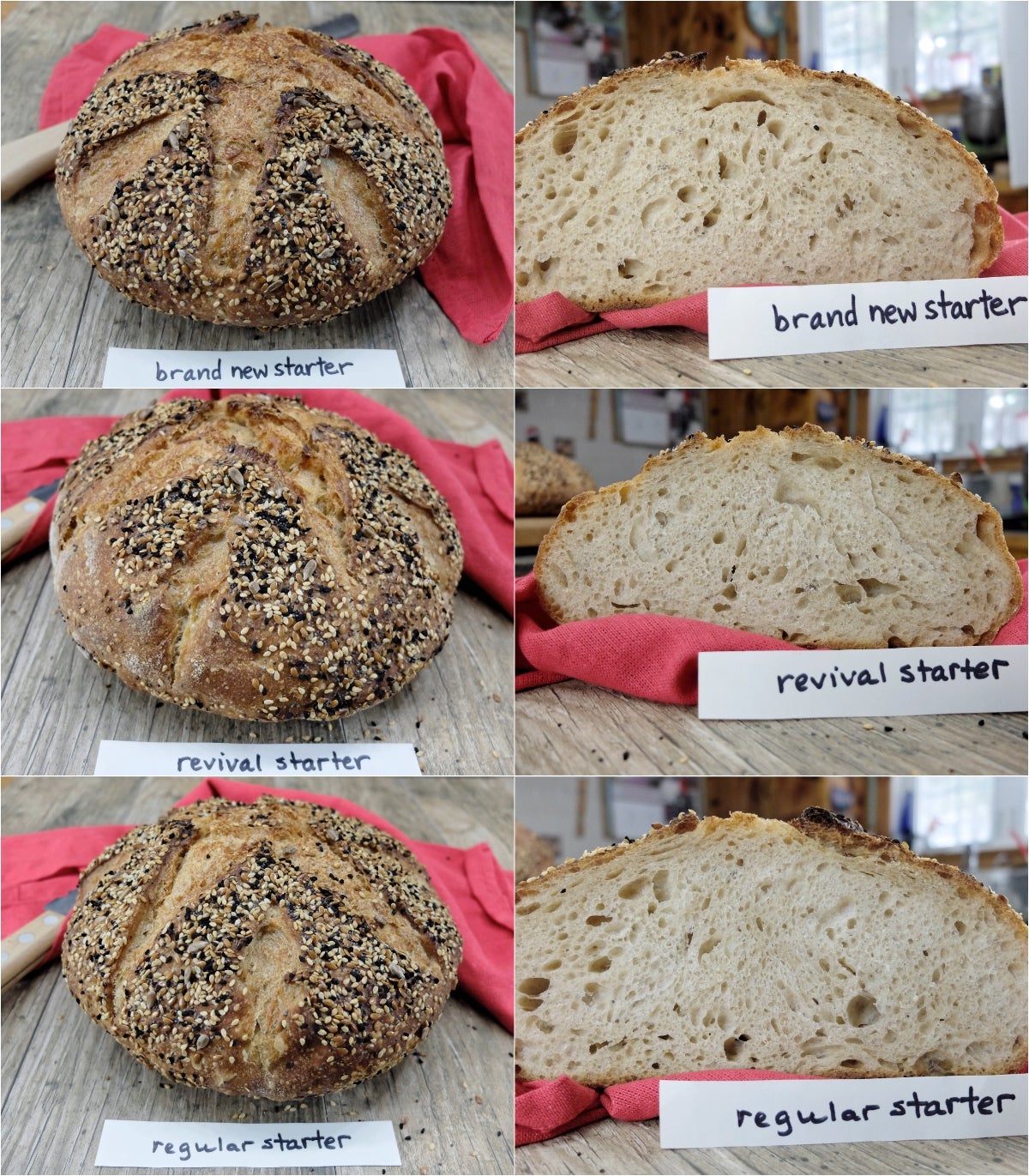


In our first sourdough starter troubleshooting post we tackled sourdough starter viability, and what will and won't cause your starter's demise. We also found out what a spoiled starter looks like, and how to know when it's time to throw it out and start over.
Today we'll take on the thorny question of whether it's worthwhile to try to revive an old but struggling starter — or if it's best to start over.
Creating your own starter from scratch is exciting and even a little magical; for details, see our step-by-step guide to creating a sourdough starter.
Simply mixing flour and water allows friendly bacteria and wild yeast to join forces and establish a balanced ecosystem that is able to impart great flavor and rise to your sourdough baking.

During the 6 to 10 days that it takes to get your starter up and running, it's a little more vulnerable to bacterial intruders and mold because it hasn't yet developed the defenses of a mature starter. But once fully developed, a well-maintained starter will readily fend off unwanted invaders and is very unlikely to spoil.
What if you inherited an old starter from your grandma and it's looking a little like it might be at death's door?

Sourdough authorities argue that there's nothing sacred about an old starter; a freshly developed "mature" starter will impart just as much flavor and rise to your bread.
Starting over with a new starter will get you back to baking great sourdough bread in a little over a week. So why take on the unpredictable task of trying to resurrect a sickly starter?
And is it even possible to thoroughly revive a starter that's sorely neglected?
Let's find out.


I start with two very neglected starters. Both starters (one all-purpose, one whole wheat) had been well-maintained until they were left at room temperature for a full month without being fed.
Why test both a white and a whole wheat starter? Starters can be maintained with all different types of flour, so I wanted to see if a whole wheat starter responded in the same way as a starter fed with all-purpose flour.


I pour the dark hooch off the neglected starters, and feed them following the feeding schedule called for in our sourdough starter recipe.
The revived starters smell a little "off" at first, but not awful; think vinegary sour, with a slightly unpleasant edge. Within four days they're rising well and have a nice, mildly tangy aroma. My theory is that both the acidity and the maturity of the neglected starters helps them fight off unwanted bacteria at the beginning of the process, which might allow for a faster return to a healthy and balanced starter.

By way of comparison, I also begin a starter from scratch. My brand-new starter is able to keep up in terms of rise. However, after four days it still smells a little funky and doesn't seem quite ready for baking bread.
On Day 4 (after only four feedings) I bake Naturally Leavened Sourdough Bread using my revived starters (which I mix together for the test), and my regularly well-maintained starters.


The results are a little shocking: two beautiful and delicious loaves. Both loaves taste mildly sour, although taste testers agree that the revived-starter loaf is slightly tangier.
On Day 5, after a total of six feedings, I try another test bake—this time including the brand-new starter; the revived starters, and my well-maintained regular starter.

Again, the results are surprising: three nice loaves, each with a similar rise and crumb structure. The only real difference is in the flavor of the breads. Each has mildly sour flavor, but the brand-new starter yields a slightly blander loaf.
It's definitely worth trying to revive a neglected starter (so long as it shows no signs of contamination). Pour off any discolored hooch, and start feeding it twice a day at room temperature. If it rises well and has a good aroma after three to four days, you're back in business!
We'd love to hear your own sourdough starter stories and questions below. Did you revive your starter from the brink of death? How long did it take? Is it thriving now?
For more information, please check out our first sourdough starter troubleshooting post.


December 2, 2021 at 1:30pm
I started my first starter last week with freshly ground whole wheat flour. I've been following King Arthur's starter and feeding recommendations from the Sourdough Starter blog. The starter is now 9 days old and hasn't grown at all, let alone double. It has gotten a nice aroma and some bubbles, but no sign of growth. Our house stays around 67-68 degrees. It sits in a mason jar on the kitchen counter with the lid barely screwed on. I've read through all King Arthur troubleshooting blogs and can't figure out why it's not growing or double in size yet.
December 3, 2021 at 10:55am
In reply to I started my first starter… by Katie (not verified)
Hi Katie, it sounds like your cooler temperatures may be slowing things down. Try to find a spot for your starter to dwell that's in the 75-80 degree range. Some people find their oven with the light on hovers at about 80F, or you could try boiling some water on the stove and then placing it in a pyrex cup in your microwave, which will warm up that small space for your starter, at least for a few hours. Replace with more hot water as needed. While it's not necessary to keep a mature starter at such warm temperatures, it can make things happen a bit faster when you're trying to create a starter from scratch. You might also try adding about 25% whole wheat or whole rye flour as part of your flour mixture, at least until your starter is rising predictably. Whole grain flours have more wild yeast present on them, so this might also give your starter a boost. For more help troubleshooting your sourdough starter, please don't hesitate to give our Baker's Hotline a call at 855-371-2253. We'd love to talk sourdough with you!
November 21, 2021 at 10:59am
Hello I have a starter that I had put in the freezer for a few months. I brought it out, thawed and fed it 2 days before I was going to bake. It smelled and looked perfect. My bread never did rise. I made another batch bread and added commercial yeast because I needed a sure thing for dinner. The bread was amazing. I recently found out how to tell if the starter is active was drop some in water to see if it floats. Nope straight to the bottom it goes. How to I make it active again? I continue to feed it and 4 days later still asleep. The new starter I made yesterday passed the drop test already but of course no sourdough smell.
November 21, 2021 at 1:34pm
In reply to Hello I have a starter that… by Tamara J Gerber (not verified)
Hi Tamara, we aren't big proponents of the float test, so I wouldn't be too discouraged if your starter isn't able to pass that particular test. Look to see that your starter is doubling in size about 6-8 hours after you feed it, and has a pleasant aroma, as good signs that it's ready to raise your bread. Be sure to add your starter to the recipe when it's "ripe," which means that it's been fed at room temperature and allowed to rise to its highest point. It's considered ripe when it's at this high point, or just beginning to fall. If your starter is bubbling and rising, those are very good signs, so I wouldn't give up on it yet. Try feeding twice a day at room temperature according to our feeding routine and see how it responds.
November 16, 2021 at 9:38pm
Hey! My new starter smells great and bubbles up nicely but it never doubles in size, no significant rise. I can’t figure out why ... it’s not young, I’ve had it for a few months now.
November 19, 2021 at 9:28am
In reply to Hey! My new starter smells… by Auri Jimenez (not verified)
HI Auri, what is your normal feeding routine? For our starter maintenance routine we recommend feeding equal parts of starter, water and flour (by weight). A typical feeding for our starter looks like: 1/2 cup (113g) starter + 1/2 cup (113g) water + 1 scant cup (113g) unbleached all-purpose flour. If you happen to be feeding equal parts by volume/cups, this is likely to result in a starter with a much thinner consistency, which will have more difficulty showing the type of doubling behavior that you're looking for with our starter. Of course, there are many ways to successfully feed and maintain a starter, and ours is just one method, so I don't want to say your starter method won't work. But if you're having trouble getting your starter to perform well in your baking, you might want to give our method a try.
November 6, 2021 at 7:52pm
My starter develops hooch after a few hours. Not much bubbling on the sides. What is wrong?
November 7, 2021 at 10:31am
In reply to My starter develops hooch… by Connie Shannon (not verified)
Hi Connie, it sounds like your starter might be composed of more water than flour, which is causing it to separate, but it's a bit hard to say without knowing more about your starter and what stage you are in terms of starter development. Is this a starter that you're creating from scratch, or a mature starter that doesn't seem to be functioning properly? How do you normally feed your starter? It's helpful to know exactly how much starter, water and flour goes into each feeding and how often you're feeding your starter. If you'd like to troubleshoot more directly, please don't hesitate to give our Baker's Hotline a call at 855-371-2253. We'd love to talk sourdough starters with you!
October 14, 2021 at 7:55am
Looking for advice/help with sourdough starter. I'm new at this! My starter bubbles and smells fine with a TBS flour and a tsp water every other day. Then, when I need more because I'm getting ready to bake I give it 100 grams both flour and water. Within hours it will have doubled. Then, hours later it will shrink. Is this normal? Is it because our kitchen is only 68 degrees? What should be my next step?
October 17, 2021 at 3:11pm
In reply to Looking for advice/help with… by Judith Doe (not verified)
Hi Judith! The doubling and shrinking is indeed quite normal. As your starter "eats it's food" it will grow and once it has run out of food it will shrink back down. It sounds like your starter is quite active and once it is doubled in size you can harvest the amount needed for your recipe and bake with it! In between baking with it you can store it in the fridge and feed it once a week. Happy baking!
Pagination